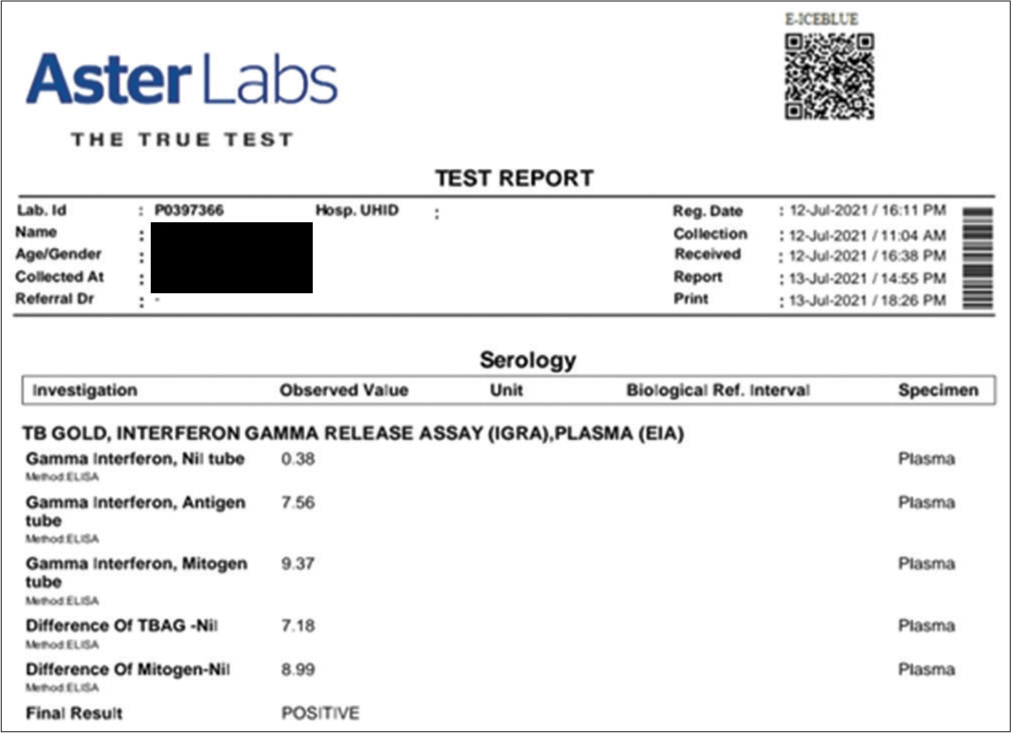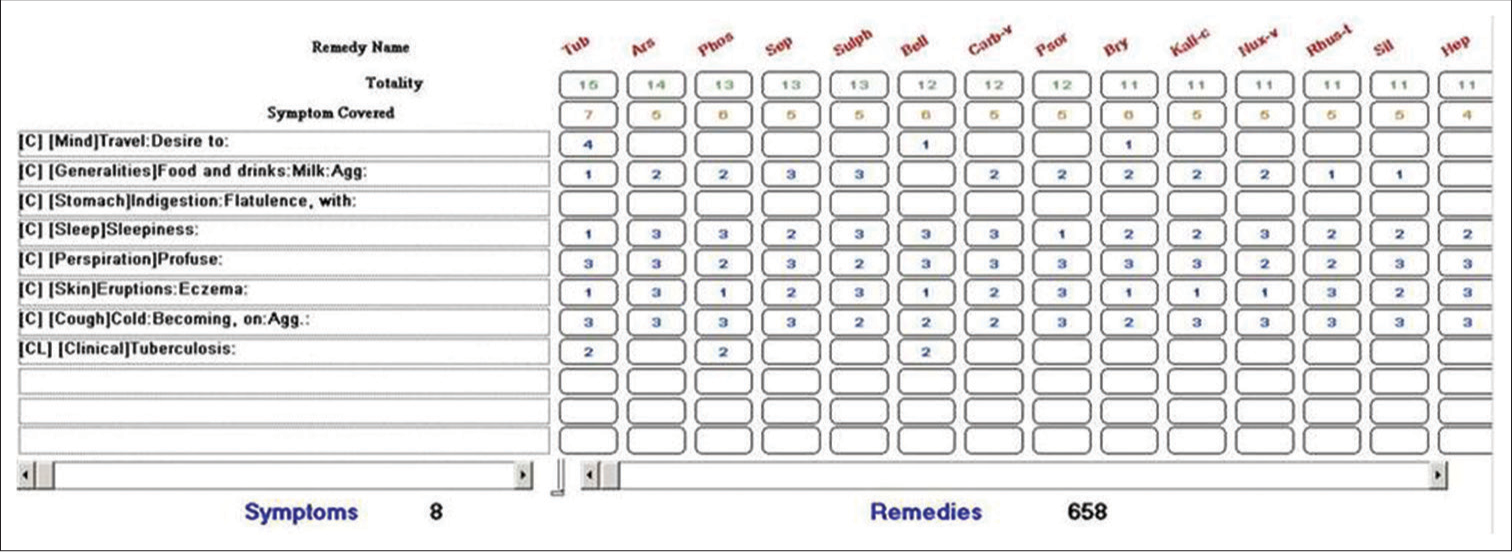Translate this page into:
Episcleritis treated with homoeopathy: A case report
*Corresponding author: Dr. Aswani Santhosh, Department of Medical Services, Dr Batra’s Positive Health Clinic Pvt. Ltd., Mumbai, Maharashtra, India. draswani.santhosh@drbatras.com
-
Received: ,
Accepted: ,
How to cite this article: Santhosh A. Episcleritis treated with homoeopathy: A case report. J Intgr Stand Homoeopathy. 2024;7:78-82. doi: 10.25259/JISH_58_2023
Abstract
Episcleritis is a common recurring infectious eye condition causing the episclera, the layer of tissue between the conjunctiva and sclera, to become inflamed, irritated and sore. It often occurs as an allergic reaction to endogenous toxins. Conventional treatment includes the use of topical steroids, nonsteroidal ointments and anti-inflammatory drugs, all of which provide temporary relief. The COVID-19 pandemic caused numerous associated ailments, including eye inflammation. Various idiopathic COVID-induced or vaccine-induced ailments were seen. Homoeopathy was proven as a prophylactic by AYUSH during the pandemic. It was used to successfully treat numerous ailments related to COVID-19 and its long-term side effects, as well as vaccine-related adverse events. This paper illustrates one such case of a 47-year-old woman with severe eye redness and pain post-COVID vaccination. Multiple ophthalmologists were consulted, but nothing worked. This case report shows the usefulness of homoeopathic medicine, Tuberculinum 200C, in treating recurrent episcleritis with no recurrence 6 months after stopping the treatment.
Keywords
Episcleritis
Idiopathic
Immune system disorder
COVID
Vaccine
Homoeopathy
INTRODUCTION
Episcleritis is an inflammation (often sectoral) of the episclera, the vascular layer between the conjunctiva and the sclera, as defined in the textbook Basics of Ophthalmology.[1] It is idiopathic in nature and associated with inflammatory problems, musculoskeletal ailments and immune system disorders. Episcleritis has two types – nodular and simple. Symptoms include redness, mild soreness or discomfort, tearing and light sensitivity. Duration is often 7–10 days. The clinical diagnosis of episcleritis is based mainly on history, external assessment and slit-lamp examination. Conjunctivitis, phlyctenular conjunctivitis, scleritis and episcleral plasmacytoma are the various differential diagnoses in cases of episcleritis.[2] If left untreated, vision impairment can occur due to advancing cataracts along with episcleritis. Glaucoma is also reported in a few cases. The presence of both cataracts and glaucoma may be due to the excess steroid use in the management of episcleritis.[3] Using medication that is side-effect-free and safe is essential to avoid such adverse effects and to treat the disorder completely. Choosing homoeopathy in such cases may be the best choice as it not only deals with the symptoms but also treats the root cause to ensure that the problem does not relapse again.
CASE REPORT
Patient information
A 47-year-old woman visited Dr. Batra’s Positive Health Clinic in Yelahanka on 30 April 2022 with severe eye redness along with pain for more than a year. She had straw-coloured thick and sticky discharge. She was previously diagnosed with episcleritis, and she was undergoing treatment with numerous allopathic doctors. She had had eczema on her hands and face in the past that had resurfaced. She was taking multiple oral tablets and applying steroid ointments, but nothing seemed to work. Her episcleritis started soon after her first dose of the Covishield vaccine, which was taken a year prior. When under allopathic treatment, a history of dormant tuberculosis was uncovered along with a positive Koch’s test [Figure 1] (the patient did not bring any reports in any of the visits to our clinic). She was prescribed an anti-tuberculosis regimen; on completing that, oral steroids were started. Symptoms initially improved, but flare-ups occurred when the steroid dose was reduced. She was referred to a rheumatologist who diagnosed an underlying immune system disorder and started her on immunosuppressants. However, immunosuppressants caused neuropathy in her lower limbs, leading to twitching and pins-and-needles sensation. After this, she decided to opt for homoeopathic treatment and avoid allopathy.

- TB GOLD TEST: Positive.
She also faces eczematous rashes on and off, the first episode being in childhood.
Physical generals
Diet: Vegetarian.
Appetite: Good.
Desire: Nothing Specific.
Aversion: Nothing Specific.
Thermal reaction: Chilly Patient. Sensitive to cold, unable to tolerate cold weather, catches cold easily, coughs, hacking, difficult to get rid of.
Thirst: Good, drinks plenty of water.
Stools: Excessive flatulence.
Urine: Normal.
Perspiration: Profuse.
Sleep: Deprived, sometimes takes melatonin spray.
Dreams: Missing a train, flying.
Food Aggravation: Milk, curd, cheese, peanut. – All-cause skin rash.
Menses: Profuse.
Physical examination
Blood pressure: 120/80 mm Hg.
Chest clear: Air entry equal; chest: clear; bilaterally symmetrical; S1 and S2 heard.
Respiratory rate: 14/min.
Other findings: No lymphadenopathy seen.
On Examination: Eyes-redness with agglutination;
Eye discharge: Straw coloured with a sticky and thick consistency; veins prominent; vision blurred initially, later improved.
Investigations
Life space
No significant findings were narrated from her childhood and college days. Her family life was not going well. She and her partner just shared the house with their kids but were slowly and steadily drifting apart. After several years of marriage, they were unaware of how they became physically as well as mentally distant while living under the same roof. They were just together for the sake of their kids.
The patient was tired of taking medicines for such a long time, and homoeopathy was her last resort. She felt physically and mentally exhausted. She looked depressed while describing her history. There was profound hopelessness that enveloped her over the years. Even she could not pinpoint whether it was due to her unhappy marriage or her tormenting physical health that was responsible for such negative feelings. She developed insomnia as well; she was constantly overthinking, and that led to overcrowding of thoughts in her mind, constantly keeping her awake.
She would be extremely happy whenever she went on a trip or spent quality time with her friends. This was a way of escaping from her otherwise hopeless and depressing life. Therefore, whenever she had time, she would prefer to be with her friends. However, her constant eye irritation and persistent redness were making her vulnerable to great discomfort and embarrassment, especially when it came to socialising with her friends. It was adversely affecting her job as well. Sometimes, she even felt that resigning from her job would be best for her as she was very depressed due to all the adverse events.
She was very sensitive, anxious and emotional. She explained how she would get hurt easily, but no one could understand it or ever tried to hear her side of the story. She was very short-tempered as well. She felt she was very giving and trusted people very quickly; therefore, people took advantage of her often. She was strong and wanted to be independent. She wanted to travel around the world someday.
Medical history
Childhood facial eczema treated with allopathic medication.
Anti-Koch’s regimen for tuberculosis.
Asymptomatic COVID infection.
Family history
Mother – Diabetes mellitus.
Materials and Methods
Complete repertory and Kent’s method were used to repertorise the case [Table 1].
| Repertory used | Rubrics selected |
|---|---|
| Complete repertory |
[MIND] travel, desire to [GENERALITIES] Food and drinks: milk, milk products and egg [STOMACH] Indigestion: flatulence with [SLEEP] sleeplessness [PERSPIRATION] profuse [SKIN]: eruption, eczema [COUGH] Cold, egg [CLINICAL] tuberculosis |
DISCUSSION
The patient’s journey of painful episcleritis was very well perceived through the detailed homoeopathic case-taking. With homoeopathic repertorisation [Figure 2], the result was focused on the following remedies including Tuberculinum, Nux vomica, Calcarea, Phosphorus and Sepia for further processing. The remedies prescribed to the patient were based on the acute as well as chronic state of affection in the patients and based on a holistic approach aimed toward the patient’s complete recovery without any relapse. The transformation images depict the evident improvement in the patient after successful and persistent homoeopathic treatment taken by the patient despite all odds. It is seen with great clarity that the treatment relieved not only her episcleritis but also her associated complaints. Even her mind was at peace after being through so much emotionally and mentally. She can experience every moment well without covering her eyes and live her life as she wants. The efficacy of the homoeopathic medicine Tuberculinum 200C in treating recurrent episcleritis with no relapse, even when the medicine was stopped for 6 months, was very well seen. The acute symptoms presented in the case, like irritation in her eye with agglutination of the infected eyes, pointed perfectly toward Euphrasia 6C, so that was administered as an acute remedy [Tables 2 and 3].

- Case analysis: Repertorial totality.

- Before treatment (30/4/2022).

- After treatment (25/9/2022).
| Remedy | Reasons | |
|---|---|---|
| Constitutional | Tuberculinum 200C | Totality of symptoms history of tuberculosis |
| Acute | Euphrasia 6C | Acute remedy aiming toward specific eye |
| symptoms such as irritation and infective complaints. | ||
| Intercurrent | Tuberculinum 1M | Anti-miasmatic for the predominant exhibition of tubercular miasm. |
| Months | Progress | Status | Prescription |
|---|---|---|---|
| 30/04/2022 | Eye redness+++ Pain persistent. Photophobia present. No new complaints. Skin rash reduced+Reference [Figure 3] |
SQ | Tuberculinum 200C/1st dose and Euphrasia 6C/2nd dose BD From 2nd week. |
| 5/06/2022 | Eye redness +++ Pain persistent. Photophobia present. No new complaints. Skin rash reduced |
SQ | Tuberculinum 200C/1st and Sac lac BD Euphrasia eye lotion LA |
| 3/07/2022 | Eye redness – reduced++Pain reduced. No new complaints. Skin rash absent. |
> | Tuberculinum 200C/1st dose and Sac lac BD |
| 31/07/2022 | Eye redness – further reduced+Pain reduced. No new complaints. | >> | Tuberculinum 200C/1st dose and Sac lac BD |
| 27/08/2022 | Eye redness is further reduced. Pain reduced. No new complaints. |
>>> | Tuberculinum 200C/1st dose and Sac lac BD |
| 25/09/2022 | Redness-Absent. Reference [Figure 4] | –o- | Tub 1M/1st dose and Sac lac BD |
| 16/10/2022 | Redness-Absent. | –o- | Tub 1M/1st dose and Sac lac BD |
| 29/11/2022 | Redness-Absent. | –o- | Sac lac BD for the month |
| 20/12/2022 | Redness-Absent. | –o- | Sac lac BD for the month |
| 22/1/2023 | Redness-Absent. | –o- | Sac lac BD for the month |
| 19/03/2023 | Redness-Absent. | –o- | Sac lac BD for the month |
| 18/03/2023 | Episcleritis –O- No recurrence from 6 months. |
Cured | Sac lac for the month. |
CONCLUSION
This case report demonstrates the utility of homoeopathy in treatment of recurrent episcleritis. However, it would not be appropriate to generalize the usefulness of homoeopathy in cases of recurrent episcleritis, on the basis of a single case report. Therefore, rigorous observational and high-quality randomized control studies with larger sample sizes are suggested to ascertain the result obtained in the present case report.
Acknowledgments
I would like to extend my sincere gratitude to Mr. T. S. Santhosh Kumar and Mrs. Geetha Santhosh, who are my constant motivators. I acknowledge all the training and motivation provided by Dr. Mukesh Batra and the support extended to me by my mentor, Dr. Jyothi Kadkol. I am grateful to Dr. Mohammed Ajmal for being my biggest critic and helping hand. I would like to thank my patient care manager Mr. Rakshit. I would like to thank Dr. Tanvi Lokhande for her help in preparing this manuscript.
Ethical approval
The Institutional Review Board approval is not required.
Declaration of patient consent
Patient’s consent is not required as patients identity is not disclosed or compromised.
Conflicts of interest
There are no conflicts of interest.
Use of artificial intelligence (AI)-assisted technology for manuscript preparation
The authors confirm that there was no use of artificial intelligence (AI)-assisted technology for assisting in the writing or editing of the manuscript and no images were manipulated using AI.
Financial support and sponsorship
Nil.
References
- Basics of opthalmology. Available from: https://www.aao.org/assets/ad448a42-b9da-4239-bdb8-f170319b7159/637825025284000000/basic-ophthalmology-sample-2022sp-pdf[Last accessed on 2023 Aug 21]
- [Google Scholar]
- Episcleritis. 2023. Available from: https://www.hopkinsmedicine.org/health/conditions-and-diseases/episcleritis[Last accessed on 2023 Aug 21]
- [Google Scholar]
- Episcleritis. 2022. United States: American Academy of Ophthalmology; Available from: https://eyewiki.aao.org/episcleritis#:~:text=episcleritis%20is%20largely%20benign%3b%20however,(adjacent%20to%20episcleral%20inflammation [Last accessed on 2023 Aug 21]
- [Google Scholar]






